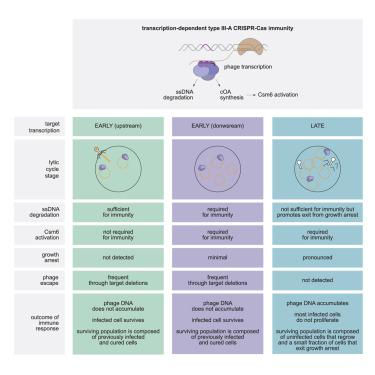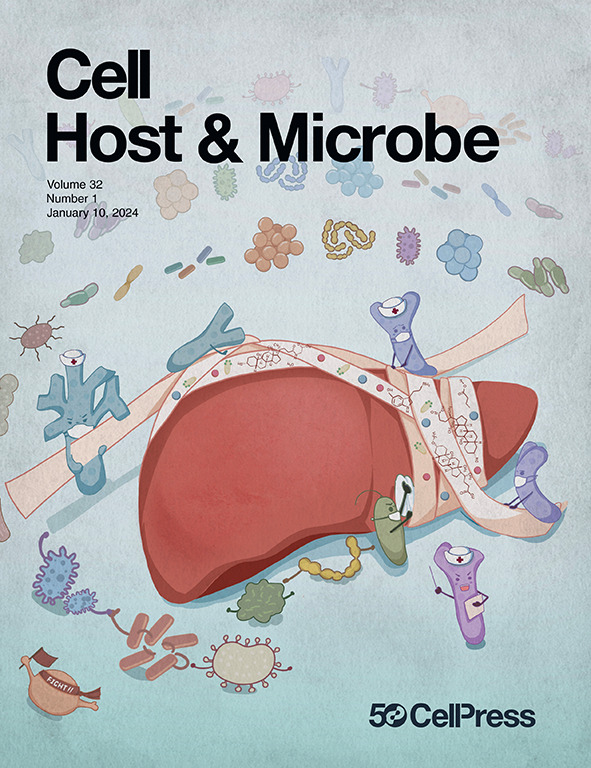Cas10 relieves host growth arrest to facilitate spacer retention during type III-A CRISPR-Cas immunity
IF 20.6
1区 医学
Q1 MICROBIOLOGY
引用次数: 0
Abstract
Cells from all kingdoms of life can enter growth arrest in unfavorable environmental conditions. Key to this process are mechanisms enabling recovery from this state. Staphylococcal type III-A CRISPR-Cas loci encode the Cas10 complex that uses a guide RNA to locate complementary viral transcripts and start an immune response. When the target sequence is expressed late in the viral lytic cycle, defense requires the activity of Csm6, a non-specific RNase that inhibits the growth of the infected cell. How Csm6 protects from infection and whether growth can be restored is not known. Here, we show that growth arrest provides immunity at the population level, preventing viral replication and allowing uninfected cells to propagate. In addition, the ssDNase activity of Cas10 is required for the regrowth of a subset of the arrested cells and the recovery of the infected host, presumably ending the immune response through degradation of the viral DNA.

在III-A型CRISPR-Cas免疫过程中,Cas10缓解宿主生长停滞,促进间隔物保留
所有生命体的细胞在不利的环境条件下都会进入生长停滞状态。此过程的关键是从该状态恢复的机制。葡萄球菌III-A型CRISPR-Cas基因座编码Cas10复合体,该复合体使用向导RNA定位互补的病毒转录物并启动免疫反应。当目标序列在病毒裂解周期的后期表达时,防御需要Csm6的活性,Csm6是一种抑制被感染细胞生长的非特异性RNase。目前尚不清楚Csm6是如何防止感染的,以及是否可以恢复生长。在这里,我们表明生长抑制在群体水平上提供免疫力,阻止病毒复制并允许未感染的细胞繁殖。此外,Cas10的ssDNase活性对于一部分被阻滞细胞的再生和被感染宿主的恢复是必需的,可能通过病毒DNA的降解来结束免疫反应。
本文章由计算机程序翻译,如有差异,请以英文原文为准。
求助全文
约1分钟内获得全文
求助全文
来源期刊

Cell host & microbe
生物-微生物学
CiteScore
45.10
自引率
1.70%
发文量
201
审稿时长
4-8 weeks
期刊介绍:
Cell Host & Microbe is a scientific journal that was launched in March 2007. The journal aims to provide a platform for scientists to exchange ideas and concepts related to the study of microbes and their interaction with host organisms at a molecular, cellular, and immune level. It publishes novel findings on a wide range of microorganisms including bacteria, fungi, parasites, and viruses. The journal focuses on the interface between the microbe and its host, whether the host is a vertebrate, invertebrate, or plant, and whether the microbe is pathogenic, non-pathogenic, or commensal. The integrated study of microbes and their interactions with each other, their host, and the cellular environment they inhabit is a unifying theme of the journal. The published work in Cell Host & Microbe is expected to be of exceptional significance within its field and also of interest to researchers in other areas. In addition to primary research articles, the journal features expert analysis, commentary, and reviews on current topics of interest in the field.
 求助内容:
求助内容: 应助结果提醒方式:
应助结果提醒方式:


